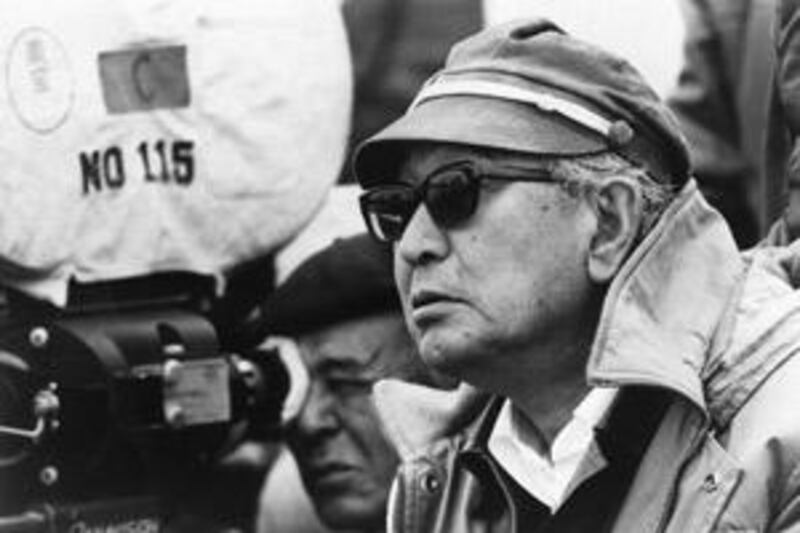If the ambience of Akira Kurosawa's breakthrough feature, Drunken Angel (Yoidore Tenshi) (1948), seems strange to those who know him through his sumptuous period pieces, the richness and complexity of its characters and narrative will be immediately familiar. The contradictions both within and among the film's characters and the film's ultimate conclusion on the worth of the human character are hallmarks of Kurosawa's cinema that Drunken Angel shows as life-long concerns of the artist.
Perhaps even more impressive, Drunken Angel is an example of an early work that shows a grasp of the intricate and multi-layered possibilities of cinematic expression at an early age. Drunken Angel has been referred to as film-noir and technically, thematically and narratively many elements of traditional noir are indeed evident. The expressionistic lighting that casts diagonal shadows across the characters and the multiple mirror-images of the conflicted characters are reminiscent of the best film-noirs and the setting in an impoverished underworld that is the focus of a social critique is classic noir.
On the surface, Drunken Angel is a straightforward tale of a tubercular yakuza hood, Matsunaga, played by Toshiro Mifune in his first of 16 collaborations with Kurosawa, and his relationship with the alcoholic Dr Sanada, played by Takashi Shimura, who practices medicine in the decrepit back alleys of post-war Tokyo. It is not only a story of apparent opposites whose hearts share far more than is readily apparent but a contradiction in character, the goodly doctor turning at times abhorrent and the mean-tempered hoodlum who, despite ourselves, garners sympathy.
Beneath the surface of the narrative, however, breathes a work of art that deftly employs the tools of the cinema to criticize the state of occupied Japan - and its occupiers - taking the yakuza underworld to task while poignantly portraying the splintered character of individual human beings. The film opens on three pan-pan girls, ladies of the night who were known for targeting occupation forces. In the background a guitar plays plucks out a melody that is strangely atonal, far from the western melodies the instrument is best known for producing. In one long shot, the camera pans from the women and slowly crosses over a filthy, bubbling bog - the film's central image - before coming to rest on the guitar player who is leaning against a crumbling wall on the opposite edge of the sludge.
Prohibited by occupation censors from filming or even mentioning the occupation forces, this opening shot somehow slipped by what was probably an overworked censor. The pan-pan girls alone are a direct reference to the US forces and, linked to the bog as a symbol of Japan's decay and the musician making non-western music with a western instrument, comprises a powerful comment. The symbolism is not the only thing that slipped by the censor. Signs in English were also prohibited from appearing in Japanese films of the period but in the scenes that take place in the marketplace signs in English appear frequently.
Matsunaga and Sanada meet in the film's second shot when Matsunaga seeks aid for an injury to his hand caused, he says, by a closing door. The puncture wound, he claims, came about from a nail in the door. When Sanada removes a bullet from his hand, he says stoically, "Some nail." There is an odd blurring of stereotypes in this sequence as the gruff doctor displays a streak of meanness and the tough though very handsome gangster displays a surprising vulnerability, especially when the question of his tuberculosis comes to the fore. It is the beginning of a contentious relationship if not a friendship as each character sees something of a kindred soul in the other. It is perhaps this perception of similarity that prompts the men's frequently expressed anger.
Kurosawa had originally intended to make the story about the doctor, concentrating apparently on the contradiction of his personal demons and his service to Tokyo's dispossessed. Another director at Japan's Toho Studios, however, suggested that Kurosawa take a look at a new actor trying out for his film, Toshiro Mifune. Kurosawa later said that he was so impressed by Mifune's performance of anger that not only was he frightened but he changed the story of Drunken Angel to focus on the relationship between the two, granting Mifune's gangster the same kind of complexity that ultimately infuses the doctor.
Mifune is startlingly on target with his portrayal of the self-destructive gang boss and it's easy to empathize with Kurosawa's enchantment. Handsome but with a sharply expressive countenance that burns with depth of character, Mifune's gangster is wholly believable both when at his worst and when at his best. It is not just the foreign occupation of Japan that Kurosawa has targeted in Drunken Angel; he also aims his camera and his characters unflinchingly at the elements of Japanese culture that he believes prompted the fool-hardiness of the Second World War. The doctor rants to two yakuza underlings about the arrival of a new age where the equality of men and women is paramount. Later, when Matsunaga tells him, "We [the yakuza] believe in honour and loyalty", Sanada responds with "Drop the feudalistic loyalty crap!" And to Matsunaga's "A yakuza never thinks of himself," Sanada laments, "Japanese make so many pointless sacrifices". And when, in use of Eisenstein's theories of montage, a shot of a sickly, crumbling Matsunaga dissolves slowly to a shot of the bog, which dissolves slowly to a crazily confident Okada. the yakuza boss that has returned from prison to reclaim his turf, Kurosawa's feelings toward the yakuza are clear.
Drunken Angel is truly a classic of the cinema, not just of Japanese cinema, and merits multiple viewings in order to fully embrace its depth of feeling and its technical mastery.





